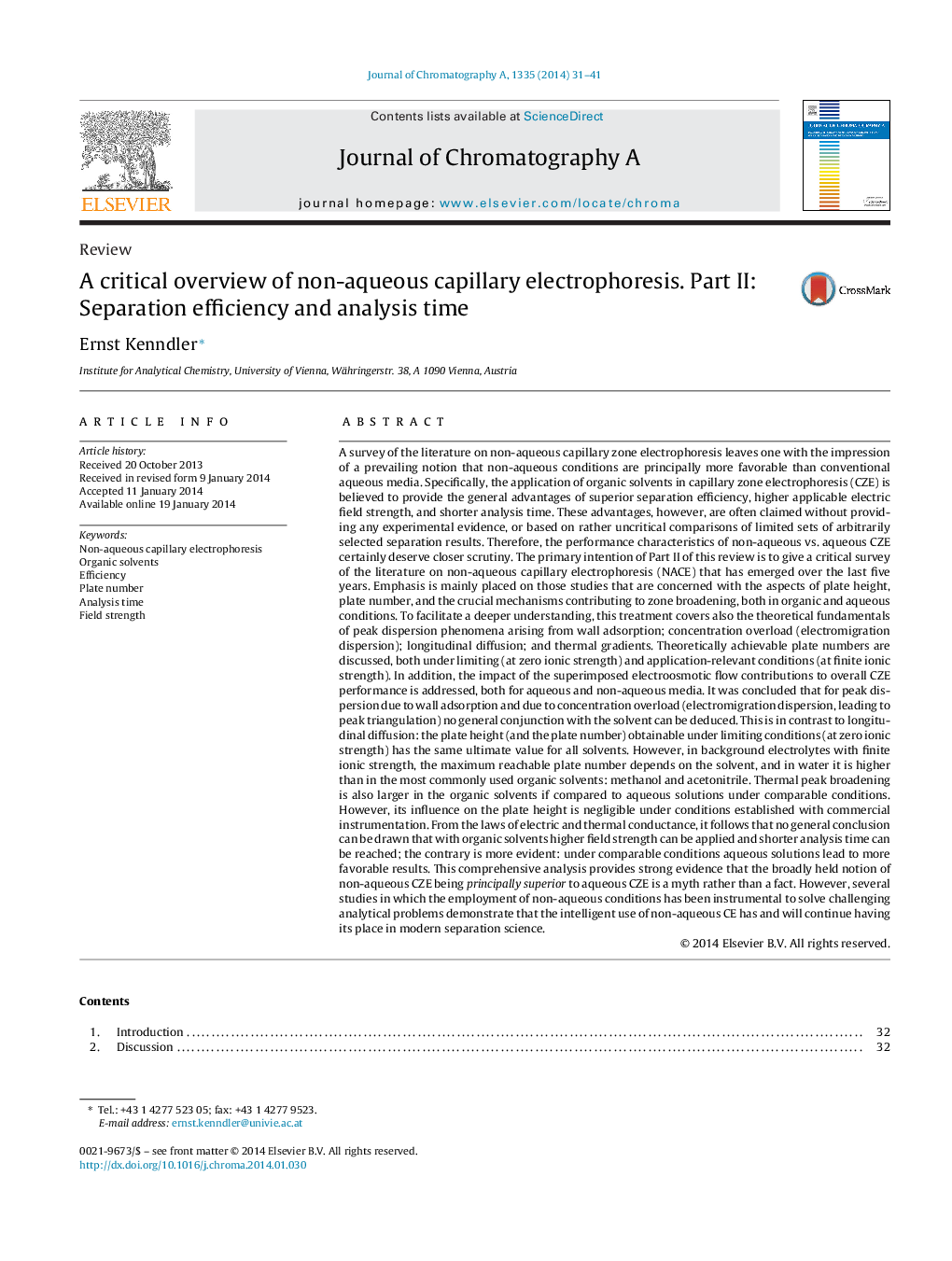| کد مقاله | کد نشریه | سال انتشار | مقاله انگلیسی | نسخه تمام متن |
|---|---|---|---|---|
| 1199940 | 1493591 | 2014 | 11 صفحه PDF | دانلود رایگان |
• I critically evaluate the practical and theoretical status of NACE over the last five years.
• I base my review on the sound background of solution chemistry in organic solvents.
• I scrutinize the progress of NACE concerning the understanding of zone broadening based on the plate height concept.
A survey of the literature on non-aqueous capillary zone electrophoresis leaves one with the impression of a prevailing notion that non-aqueous conditions are principally more favorable than conventional aqueous media. Specifically, the application of organic solvents in capillary zone electrophoresis (CZE) is believed to provide the general advantages of superior separation efficiency, higher applicable electric field strength, and shorter analysis time. These advantages, however, are often claimed without providing any experimental evidence, or based on rather uncritical comparisons of limited sets of arbitrarily selected separation results. Therefore, the performance characteristics of non-aqueous vs. aqueous CZE certainly deserve closer scrutiny. The primary intention of Part II of this review is to give a critical survey of the literature on non-aqueous capillary electrophoresis (NACE) that has emerged over the last five years. Emphasis is mainly placed on those studies that are concerned with the aspects of plate height, plate number, and the crucial mechanisms contributing to zone broadening, both in organic and aqueous conditions. To facilitate a deeper understanding, this treatment covers also the theoretical fundamentals of peak dispersion phenomena arising from wall adsorption; concentration overload (electromigration dispersion); longitudinal diffusion; and thermal gradients. Theoretically achievable plate numbers are discussed, both under limiting (at zero ionic strength) and application-relevant conditions (at finite ionic strength). In addition, the impact of the superimposed electroosmotic flow contributions to overall CZE performance is addressed, both for aqueous and non-aqueous media. It was concluded that for peak dispersion due to wall adsorption and due to concentration overload (electromigration dispersion, leading to peak triangulation) no general conjunction with the solvent can be deduced. This is in contrast to longitudinal diffusion: the plate height (and the plate number) obtainable under limiting conditions (at zero ionic strength) has the same ultimate value for all solvents. However, in background electrolytes with finite ionic strength, the maximum reachable plate number depends on the solvent, and in water it is higher than in the most commonly used organic solvents: methanol and acetonitrile. Thermal peak broadening is also larger in the organic solvents if compared to aqueous solutions under comparable conditions. However, its influence on the plate height is negligible under conditions established with commercial instrumentation. From the laws of electric and thermal conductance, it follows that no general conclusion can be drawn that with organic solvents higher field strength can be applied and shorter analysis time can be reached; the contrary is more evident: under comparable conditions aqueous solutions lead to more favorable results. This comprehensive analysis provides strong evidence that the broadly held notion of non-aqueous CZE being principally superior to aqueous CZE is a myth rather than a fact. However, several studies in which the employment of non-aqueous conditions has been instrumental to solve challenging analytical problems demonstrate that the intelligent use of non-aqueous CE has and will continue having its place in modern separation science.
Journal: Journal of Chromatography A - Volume 1335, 28 March 2014, Pages 31–41
